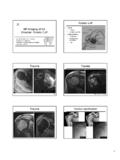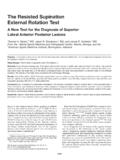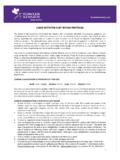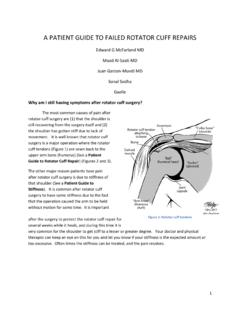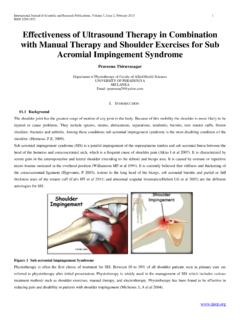Transcription of Shoulder MRI indications - micmri.com
1 Primary indications for MRI of the Shoulder include, but are not limited to, diagnosis, exclusion, and grading of suspected: 1. rotator cuff abnormalities: supraspinatus, infraspinatus, and/or subscapularis full- thickness and partial - thickness tears, tendonopathy, tendonitis 2. Disorders of the long head of the biceps brachii: full- thickness and partial - thickness tears, tendonopathy, tendonitis, subluxation, dislocation 3. Conditions affecting the supraspinatus outlet: acromial shape, os acromiale, subacromial spurs, acromioclavicular joint disorders, subacromial bursitis 4. Labral abnormalities: cysts, degeneration, and tears, including superior labrum anterior posterior (SLAP) and Bankart lesions and their variants 5.
2 Muscle disorders affecting the Shoulder girdle: atrophy, hypertrophy, denervation, masses, injuries 6. Osteochondral and articular cartilage infractions of the glenohumeral joint: osteochondral fractures, osteochondritis dissecans, degenerative chondrosis, chondromalacia, and chondral fissures, fractures, flaps, and separations 7. Loose bodies, chondral, osteochondral, osseous 8. Synovial-based disorders: synovitis, bursitis, metaplasia and neoplasia 9. Marrow abnormalities: avascular necrosis, marrow edema syndromes, and stress fractures 10. Neoplasms of bone, joint or soft tissue 11. Infections of bone, joint or soft tissue 12.
3 Congenital and developmental conditions: dysplasia, normal variants 13. Vascular conditions: entrapment, aneurysm, stenosis, and occlusion 14. Neurologic conditions: entrapment, compression, masses, and peripheral neuritis MRI of the Shoulder may be indicated to further clarify and stage conditions diagnosed clinically and/or suggested by other imaging modalities including, but not limited to: 1. Arthritides: inflammatory, infectious 2. Primary and secondary bone and soft tissue tumors 3. Fractures and dislocations MRI of the Shoulder may be useful to evaluate specific clinical scenarios, including, but not limited to: 1.
4 Prolonged, refractory, or unexplained Shoulder pain 2. Acute Shoulder trauma 3. Impingement syndrome: subacromial, subcoracoid, internal 4. Glenohumeral instability: chronic, recurrent, subacute, acute dislocation, and subluxation 5. Shoulder symptoms in the overhead or throwing athelete 6. Mechanical Shoulder symptoms: catching, locking, napping, crepitus 7. Limited or painful range of motion 8. Swelling, enlargement, mass, or atrophy 9. Patients for whom diagnostic or therapeutic arthroscopy is planned 10. Patients with recurrent, residual, or new symptoms following Shoulder surgery
